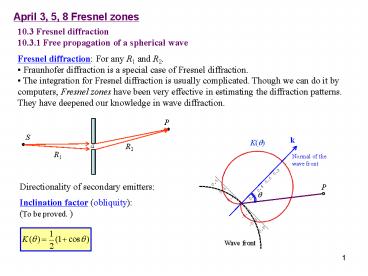10.3 Fresnel diffraction - PowerPoint PPT Presentation
1 / 23
Title:
10.3 Fresnel diffraction
Description:
Title: Slide 1 Author: pw103 Last modified by: Pengqian Wang Created Date: 8/19/2006 6:56:17 AM Document presentation format: On-screen Show (4:3) Company – PowerPoint PPT presentation
Number of Views:806
Avg rating:3.0/5.0
Title: 10.3 Fresnel diffraction
1
April 3, 5, 8 Fresnel zones
- 10.3 Fresnel diffraction
- 10.3.1 Free propagation of a spherical wave
- Fresnel diffraction For any R1 and R2.
- Fraunhofer diffraction is a special case of
Fresnel diffraction. - The integration for Fresnel diffraction is
usually complicated. Though we can do it by
computers, Fresnel zones have been very effective
in estimating the diffraction patterns. They have
deepened our knowledge in wave diffraction.
Directionality of secondary emitters Inclination
factor (obliquity) (To be proved. )
2
Free propagation of a spherical monochromatic
wave Primary spherical wave Question What is
the field at P which is r0 away from the sphere?
Contribution from the sources inside a slice ring
dS
S
P
x
r
r0
O
r
r
dS
The area of the slice ring is
3
Contribution from the l th zone to the field at P
4
Sum of the disturbance at P from all zones on the
sphere
5
Note Huygens-Fresnel diffraction theory is an
approximation of the more accurate
Fresnel-Kirchhoff formula.
6
10.3.2 The vibration curve A graphic method for
qualitatively analyzing diffraction problems with
circular symmetry. Phasor representation of waves.
- For the first zone
- Divide the zone into N subzones.
- Each subzone has a phase shift of p /N.
- The phasor chain deviates slightly from a circle
due to the inclination factor. - When N? 8, the phasor train composes a smooth
spiral called a vibration curve.
7
(No Transcript)
8
So you wont forget it.
9
(No Transcript)
10
Read Ch10 3 Homework Ch10 42,43,44 Due April
12
11
April 10 Circular apertures
12
2) P out-of axis As P moves outward, portions of
the zones (defined by P, S and O) will be
uncovered and covered, resulting in a series of
relative maxima and minima. (The integration will
be very complicated.)
13
II. Plane waves
Example
On-axis field
14
Read Ch10 3 Homework Ch10 46,52,53,54,55 Due
April 19
15
April 12 Fresnel zone plate
10.3.4 Circular obstacles Poissons spot Bright
spot always appears at the center of the shadow
of a circular obstacle. Poisson intended to use
this unusual conclusion to deny Fresnels wave
description of light, but this prediction was
soon verified to be true. The spot is ironically
called Poissons spot. May have been observed by
ancient people.
The spot is everywhere along the axis except
immediately behind the obstacle. The irradiance
is not very different from that of the
unobstructed wave.
16
10.3.5 Fresnel zone plate Zone plate A device
that modifies light by using Fresnel zones.
Modification can be either in amplitude or in
phase. Example Transparent only for odd (or
even) zones. The first 10 odd (even) zones will
result in an intensity of 400 times larger
compared to the unobstructed light.
I. For spherical waves
Radii of the zones
17
II. For plane waves
Radii of the zones
Primary focal length
Third-order focal length because
Fabrication of zone plates Photographically
reduce large drawings. Newtons rings serves as
good pictures for this purpose.
18
Read Ch10 3 No homework
19
April 15,22 Rectangular apertures
10.3.6 Fresnel integrals and the rectangular
apertures Fresnel diffraction with no circular
symmetry. The zone idea does not work.
The contribution to field at P from sources in dS
- K(q) 1 if the aperture is small (ltltr0, r0).
- In the amplitude r r0, r r0.
- In the phase
Half of the unobstructed field Eu/2
Fresnel integrals
20
Fresnel integrals
- Ep and Ip can be evaluated using a look-up
table. - Off-axis P points can be estimated by
equivalently shifting the aperture and changing
the limits (u1, u2, v1, v2) in the integrals
according to the new values of (y1, y2, z1, z2). - It also applies to special apertures, such as
single slit, knife-edge, and narrow obstacle.
What we need to do is just to find the values of
u1, u2, v1 and v2.
21
Plane wave incidence
Notes on how to find u1, u2, v1 , and v2
- Project the viewing point P onto the aperture
plane, call the projection P'. - Let P' be the origin of the coordinate system,
let the y and z axes be parallel to the two sides
of the aperture. - (y1, y2, z1, z2) are the coordinates of the four
limits of the aperture, when viewed at P'.Please
note that they are not the size of the aperture.
Also y2-y1 a, z2-z1 b.
22
Example Fresnel diffraction of a plane wave
incidence on a rectangular aperture Aperture 2
mm2 mm, l500 nm. (a2/l 8 m) For any point P
(X in m, Y in mm, Z in mm)
23
- Read Ch10 3
- Homework (Optional)
- Using Mathematica, draw the following three
diffraction patterns (contour plots) for a plane
wave incidence on a rectangular aperture. - Aperture 2 mm2 mm l 500 nm Screen 0.4 m,
4 m and 40 m away. - Note
- Describe the procedures of how you calculate the
intensity distribution. - In Mathematica the Fresnel integral functions are
FresnelC and FresnelS. You may need to
study ListContourPlot or ListPlot3D. - For each distance adjust the screen area you plot
so that you can see the main features of the
pattern. - Use logarithmic scale for the intensity
distribution. Let each picture span the same
orders of magnitude of intensity down from its
maximum. - Discuss the evolution of the diffraction patterns
for the above three distances. - Due April 26































